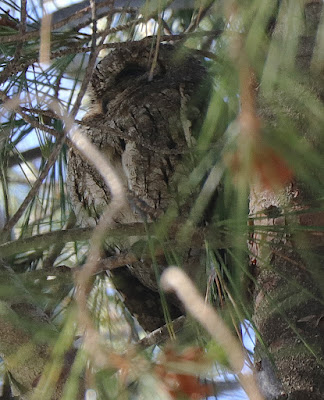After yesterday I just knew that Oystercatcher nest was close to the road. But why would the silly birds make their nest just 12 inches from the verge where vehicles whizz by and where just yards away large wagons and other vehicles park while the occupants stretch their legs.
Feet away on the other side of the hedgerow is Conder Pool with tons of places they might set up home. The “oyks” picked a spot where a tiny area of gravel lies next to a roadside marker post. Good luck with that - they will need it.
Oystercatcher
Oystercatcher nest
Oystercatcher nest
Maybe the other pairs of Oystercatchers, at least four others around the pool, chased them away, or possibly the two pairs of Avocets? I noted that the female Common Tern is now sat on her nest on the floating pontoon, the bird just visible behind the opaque screen while the male stood guard just a metre away.
Also today in my flying visit – 120 Black-tailed Godwit, 8 Tufted Duck, 6 Little Egret, 2 Wigeon, 2 Greylags, and a handful of both Sand Martins and Swallows. Two Ravens croaked overhead as they flew around in a circle and then back up the river towards Lancaster.
Greylags
Black-tailed Godwit
I drove down towards Bank End in time to see a rainbow and just before it dissolved into the morning sunshine.
Bank End, Cockerham
Bank End, Cockerham
The quarry held about 120+ Sand Martins, two pairs of Oystercatcher and a pair of Redshanks. At the end of the lane I counted 15/20 Lapwing and 6 Oystercatcher on the bare earth field where I think the farmer has designs that don’t include nesting waders. In the coppice there was both Blackcap and Willow Warbler in song plus a male Reed Bunting singing from a post on the marsh. I watched the male fly into a patch of reedy marsh and where it was joined by a female.
Redshank
A Pied Wagtail waited for my car to move as she sat on a barbed wire fence with a bill full of sheep’s’ wool with which to line her nest. There’s enough sheep’s wool around here to line a million nests. Eight or ten Brown Hares were having a frenzied chase around until one stopped to take a morning wash.
Brown Hare
Pied Wagtail
I had things to do like still catching up from Menorca, but time to take a look at Gulf Lane.
Farmer Richard has replanted his set-aside with a crop of wild bird seed and other goodies so that the field looks spot-on for a productive autumn of ringing as long as there’s no more avian flu.
There was Sedge Warbler singing from the ditch, Oystercatcher on eggs, a pair of Skylarks, 5 Stock Dove and a distant Buzzard.
































































.JPG)






.jpg)











